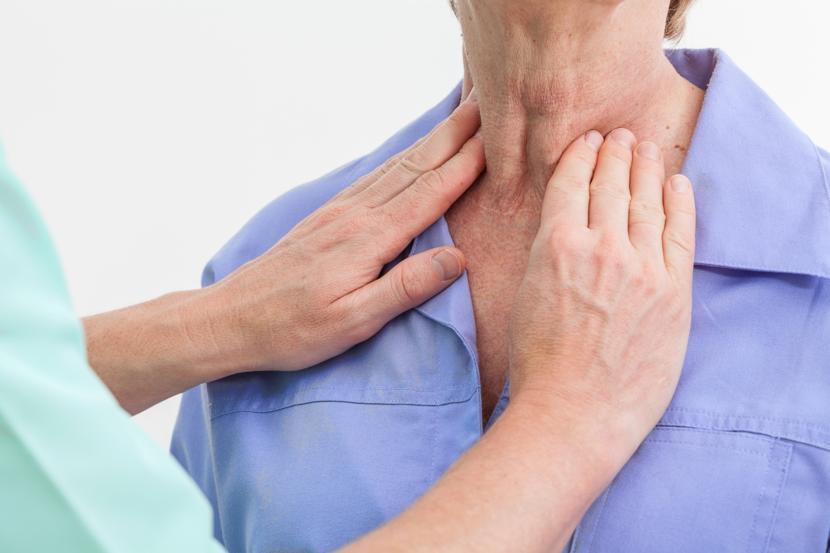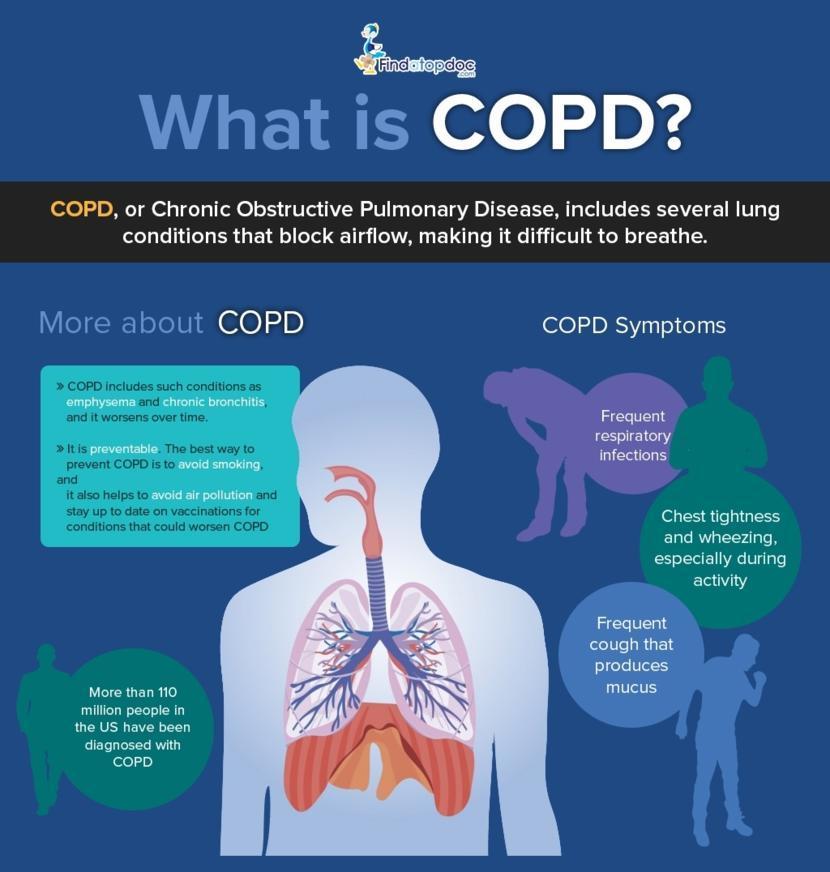COPD: Know the Signs and Symptoms – Pink Puffers and Blue Bloaters

COPD is a chronic lung condition that makes it difficult for you to breathe. Know about the signs and symptoms of chronic obstructive pulmonary disease (COPD), Blue Bloater and Pink puffer do not develop until the later stages of this disease. COPD is a term used to describe progressive lung diseases including emphysema, chronic bronchitis, refractory asthma and some forms of bronchiectasis.
Patients with COPD are asymptomatic in the early stages of the disease. However, as time passes and significant lung damage has occurred, patients develop a large spectrum of symptoms. The two types of COPD are type A (emphysema) and type B (chronic bronchitis). The symptoms will worsen over time, especially if the individual is exposed to cigarette smoke.
Although chronic bronchitis (blue bloater) and emphysema (pink puffer) frequently co-exist rarely, features of one type may be predominant.
Many people mistake their coughing and difficulty in breathing as signs of normal aging do not notice the bigger problem it may pose to their health if these signs are further ignored. The symptoms of COPD are not easily noticeable in the initial stages. One notices the symptoms in the more advanced stages of the disease.
Early screening helps to identify COPD before it affects the functioning of the lungs.
Symptoms of COPD –
- Frequent coughs (with or without sputum)
- Tightness in the chest
- Wheezing
Difficulty in breathing or feeling breathless
Predominantly emphysema (Type A)
These patients usually have a present chronic cough that produces very little mucoid sputum. Moreover, they have a long history of exertional dyspnea (shortness of breath with physical activity). With this disease, patients may have difficulty breathing doing small activities, such as getting dressed. Wheezing, a whistling within the chest, is another symptom of type A. Wheezing is often accompanied by tightness of the chest.
Type A patients are often found hunched over to improve quality of breathing. Their mouthes are normally open and nostrils then become dilated to overcome ventilator difficulty. Due to ventilator difficulty, their ventilator rate is increased (puffers) to somehow maintain their oxygenation of the blood (pink). Therefore, patients with type A COPD are sometimes known as “pink puffers”.
In examinations of a patients with type A COPD, they often appeared to be distressed, had significant weight loss, and used accessory muscles for respiration. Tachypnea and prolonged expiration through pursed lip breathing is a feature of these patients.
In a nutshell, the signs and symptoms of emphysema are:
- Chronic cough that produces very little sputum
- Exertional dyspnea
- Wheezing
- Leaning forward to use accessory muscles to assist in breathing
- Mouth open and nostril dilated
- Distressed
- Tachypnea
- Pursed lip breathing
- Hyper inflated lungs
- Hyper resonant lung fields
Emphysema results from destruction of the airways to the terminal bronchiole. It also includes the gradual destruction of the pulmonary capillary bed. This results to decreased inability to oxygenate the blood. This results to less ventilation, less surface area for gas exchange. Because of low cardiac output, people facing this issue develop muscle wasting and weight loss. They actually have less hypoxemia thus start to appear as “pink” hence the name “pink puffer”. Some of the pink appearance may just be because of the work the individual puts up into just taking a breath.
Predominantly chronic bronchitis (Type B)
Patients with chronic bronchitis have a chronic cough for at least three months, and they produce large amounts of sputum. This is one of the first signs of COPD. Coughing is a reflex that initiates to remove the excess mucous that is stuck in your air passages that make it difficult to breathe. Although all individuals experience coughing, a chronic cough indicates that your lungs are not functioning properly. A large amount of sputum is produced to trap the particles and other noxious agents found in cigarette smoke. Therefore, large amounts of sputum will be coughed up by patients with chronic bronchitis.
These patients have marked obstruction of the airways and cannot hyperventilate to maintain the oxygenation of blood. Therefore, there is a decrease in the oxygenation of blood and increased levels of carbon dioxide in the arterial blood, and appear cyanosed (blue). Unlike emphysema, the pulmonary capillary bed in blue bloater is not damaged.
Patients also develop pulmonary hypertension caused by the marked changes in the lung tissues. This makes the heart pump harder to compensate for the high pressure in the lungs, to supply blood to the lungs, and can eventually lead heart failure. Peripheral edema (bloater) due to heart failure is a predominant feature. Therefore, patients with type B COPD are known as “Blue Bloaters”.
In a nutshell, the features of chronic bronchitis include:
- A chronic cough that produces large amounts of mucoid or purulent sputum.
- Frequent respiratory infections
- Peripheral edema
People with COPD are more likely to develop recurrent lung infections that cause acute exacerbations of this disease. During these episodes, an individual's symptoms become worse than before, and usually persist for several days. It is vital that you consult with your doctor to manage these flare ups as soon as possible. Severe and worsening exacerbations can be fatal if untreated.
Causes of COPD –
Most cases of COPD are caused by pollutants which includes, smoking or second hand smoking. Work environments also pose threats of COPD and are contributing factors for the rise of this disease among individuals. Few of the examples are fumes, dust and chemicals. An individual’s genetic factor also contributes to the rise of COPD among individuals.
Smoking – COPD occurs mostly to individuals of age 40 and above with a history of smoking. These may be individuals who are currently smoking or were smoking earlier.
Environmental factors – Individuals who are exposed to harmful pollutants at their workplace for longer duration are at risk of COPD. Second hand smoke or other lung irritants at home such as organic fuel may also cause COPD among individuals.
Genetic Factor – Even if a person has never smoked or been exposed to irritant pollutants, they can still develop COPD. Antitrypsin deficiency is one of the common genetic factor for emphysema2.
COPD gets worse over the course of time. This damage cannot be reversed back however you can take steps to prevent further damage to your lungs.
COPD Diagnosis –
A person may develop COPD but not notice the signs or symptoms until it is at a more developing stage. Hence it’s important to check with your doctor and ask for a breathing test to be carried out if you are a smoker whether current or former, or being exposed to harmful lung irritants or have a family history of COPD.
The breathing test or spirometry test measures how well an individual’s lungs are functioning. It is a very simple and easy test that can diagnose COPD. Spirometry is simple and non-invasive test to identify COPD in a person. You will be asked to blow all the air out of your lungs into a mouthpiece connected to a machine which is known as spirometer. The machine will then calculate two numbers: firstly, the amount of air blown out in the first second and the amount of air you blow out in six seconds or more. This test also lets your doctor identify the severity of COPD in an individual.
Apart from spirometer the doctor will:
- Conduct a physical examination and listen to your lungs
- Conduct chest X-Rays and other tests to rule out other problems if any causing your symptoms.
- Ask you questions about your past health or family history.
When should an individual get tested for COPD –
- Has wheezing trouble
- History of smoking
- Passive smoker
- Chronic coughing with or without sputum
- Exposure to harmful air pollutants
Treatment of COPD –
The doctor would prescribe certain treatments that will help ease your symptoms and make you feel better:
- Medications can help one breathe easier. Most of them would be inhalers so they go directly in your lungs. You should use it just the way as prescribed by the doctor.
- A lung rehab program also would help manage the disease. There would be counselling and exercise sessions on how to better take care of yourself.
- Quit smoking
Types of medicines usually prescribed for COPD –
Bronchodilator – they relax muscles around the airways which makes breathing easier. They are often delivered via nebulizer or inhalers so the medicines go straight in your lungs. Few of the bronchodilator can be swallowed as pill. Short and long acting bronchodilator work in different ways.
Anti-inflammatory medicines – Corticosteroids or steroids are few medicines which reduce inflammation. However, steroids have side effects such as weight gain, diabetes, cataracts etc.
The doctor may also prescribe certain antibiotics or vaccinations if required.
Lifestyle changes –
- Ensure regular yoga or exercises are carried out to keep your lungs and body healthier.
- Follow strict healthy diet with consultation from the doctor. Have fresh fruits and vegetables to strengthen your body.
- Use an air filter at home or office if possible.
- Strictly avoid any air pollutants that can worsen the condition of your lungs.
- Keep depression or anxiety at bay. Knowing a person has disease which is difficult to be cured over time can get worse and may have a mental setback. The person may feel sad or depressed. These feelings can worsen your condition and the effect of the medicines may not work well if there is stress always in your mind. Hence go for counselling sessions or take part in health groups.
- Check with your doctor on when you can take influenza and pneumonia vaccinations. These vaccines lower the chances of getting the illness which are one of the major health risks posed for patients with COPD.
Smaller activities in our day to day life can also help manage the illness and its symptoms:
- Keep items at your reach wherein you won’t need to get too much worked up while searching them.
- Do activities slowly and avoid rushing with any activities.
- Find simple ways to cook, and do other chores at home or office.
- Wear loose clothes and shoes that are easy to put on and take off.

















